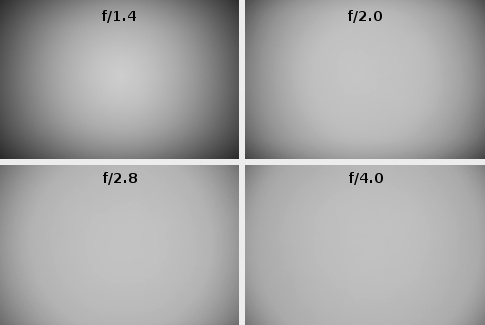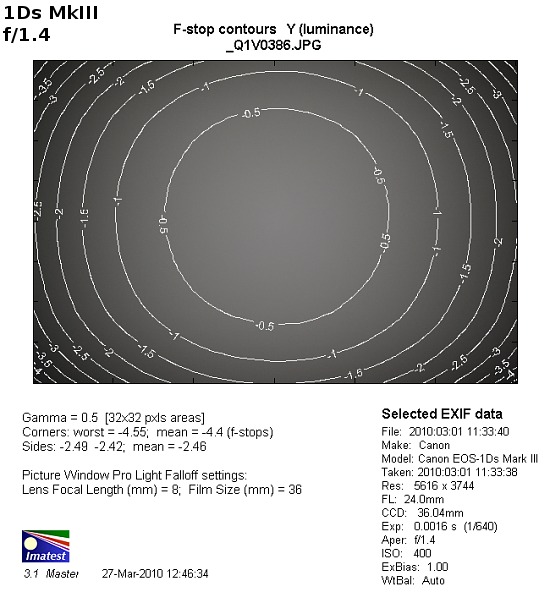Canon EF 24 mm f/1.4L II USM
8. Vignetting

When we start testing the lens on the full frame there are some problems. Perhaps we put it too mildly after all -it’s enough to glance at the photos below to understand that we face serious issue.
Please Support UsIf you enjoy our reviews and articles, and you want us to continue our work please, support our website by donating through PayPal. The funds are going to be used for paying our editorial team, renting servers, and equipping our testing studio; only that way we will be able to continue providing you interesting content for free. |
- - - - - - - - - - - - - - - - - - - - - - - - - - - - - - - - - - - - - - - - - - - - - - - -

Fast lenses made us accustomed to the fact that on full frame their vignetting might reach even 3 EV. The Canon EF 24 mm f/1.4 USM II, though, breaks very disgraceful records here. At the maximum relative aperture its vignetting achieves a truly monstrous value of –4.4 EV which means that only 22% of light gets to the frame corners. If you try to light such a photo up it will hurt – there will be too much noise. For instance a picture taken with the ISO speed set at 200 will have the noise worse than at ISO 3200 after getting rid of such vignetting. Some people will keep the vignetting and praise the tested lens for its outstanding artistic vividness – well, there is no accounting for tastes.
On stopping down we see the vignetting decreasing but we can’t eliminate it completely. By f/2.0 the brightness loss in the frame corners amounts to 62%, by f/2.8 it reaches 43% and by f/4.0 it is still at a bothersome level of 37%. On further stopping down we see just slight decrease. By f/5.6 the vignetting is 31%, by f/8.0 it amounts to 26% and by f/11 it decreases by next 3%.
One important thing should be emphasized in this chapter. Many people underestimate the vignetting. They say it is easy to remove and often it gives a sought-after effect to a photo. While it is quite easy to add a vignetting effect to any picture without deteriorating its quality, if you want to remove it, it’s a different story. We already mentioned a significant increase of grain/noise when you try to light up a photo. The second side effect, connected very tightly with vignetting because it is, so to speak, its direct cause, is the light fall-off in the frame corners. It means a reduction of an effective gathering light area, and, after all, the resolution of an optical system depends on it. The vignetting entails the loss of resolution; it is one of the reasons why the tested lens has low resolution in full frame corners by f/1.4 and f/2.0. Perhaps it is unnecessary to add that once you lose some resolution it cannot be retrieved using any graphics software.
 |






